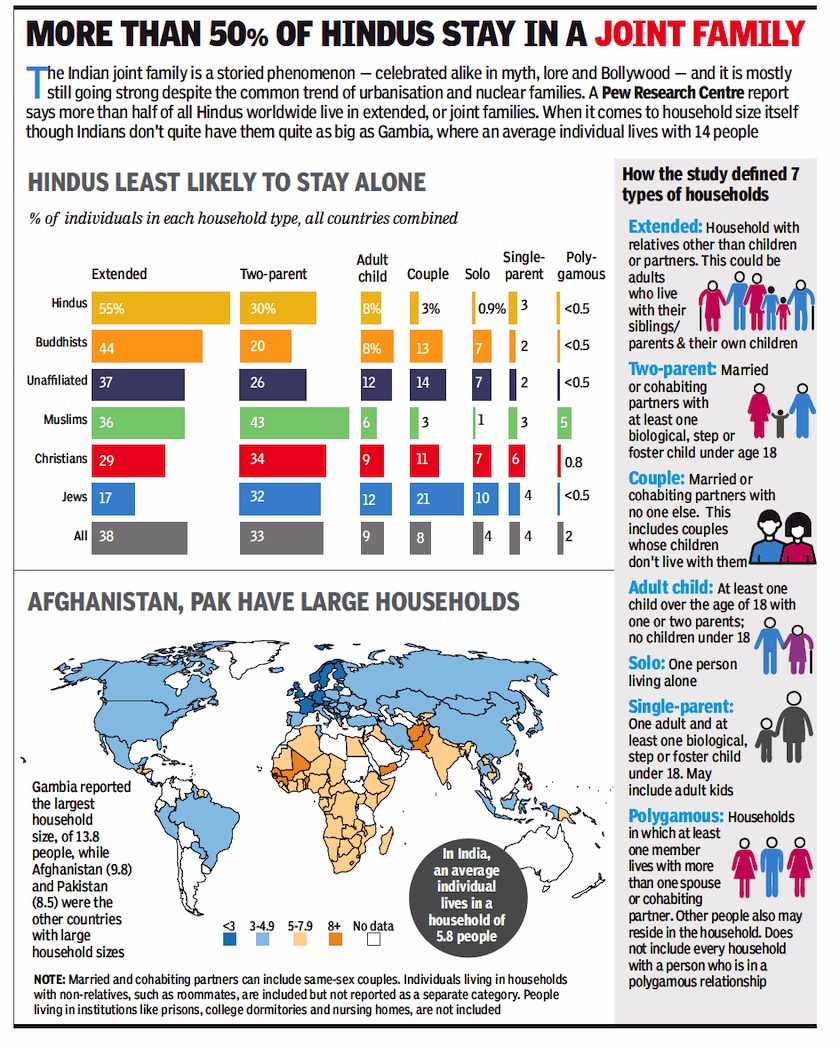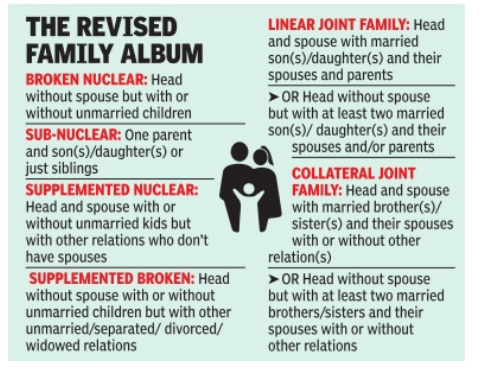Families: India
This is a collection of articles archived for the excellence of their content. |
Contents |
Joint families
2017: Joint families continue
Why joint families are back in urban India|Jul 16 2017: The Times of India (Delhi)
Big fat families are not just the stuff of movies. New realities like the need for childcare, support for elderly and rising housing expenses are making many come together again What does an Indian family look like? Mummy-Daddy kiddies in the city? Or a big branching family tree in the villages, with several generations living under one roof, as TV serials and Barjatyas show it? Turns out, neither assumption is right. Recently released government data reveals that even as families are increasingly fragmenting in rural areas, more people in cities are choosing to live in extended families.Between 2001 and 2011, joint families in urban India grew 29%, whereas in rural areas they rose only 2%. Then there are the hybrid models -sub-nuclear units when one spouse passes or when siblings live together, or supplemented nuclear, as when an unmarried relative adds to a nuclear unit. Because of migration, support needs for the elderly and for children, and the need to share resources, urban families are stretching, joining and evolving.
Take the Bhatnagars in Bengaluru. When Siddhartha moved to the city for his IT job, his family was scattered all over India -his brother Prateek was at college in Chandigarh, his sister Archana in Jaipur, his mother in their native Lucknow and his father posted in Vadodara.After he got married in 2009, he brought his parents to the city he'd made home. Soon, his brother moved there too, after he got a banking job. Archana and her seven-yearold daughter have also joined the brood, and now the family of nine lives out of a five-bedroom flat in Mahadevapura. “My wife Pooja, whom I dated for a decade, knew my family and understood that I would live with my parents, brother and his family -all together. She has also been brought up in a joint fam ily. It was pointless to stay in two different houses when my brother and sister-in-law are so warm,“ says Prateek. “We, my father, brother and sister, pool money and use it to run the household,“ says Siddhartha.
This tendency for families to cluster in cities shouldn't surprise us, says Rajni Palriwala, sociologist at the Delhi School of Economics.The rising cost of housing, the fact that more women work outside the home and children need looking after, the vulnerability of the elderly , the mutual support offered by a big family are all reasons to stay together in the city. “We felt guilty that our parents were far away , and getting older and frailer while we made our lives in Delhi,“ says Gajendra Singh, who works in Delhi as a driver, and whose wife and parents live with him now. His wife's brother also stays with them intermittently, while working temporary jobs. “We eat together, live together, and it is a source of comfort rather than a stress. My mother misses the hills and weather of Uttarakhand, but she is happy with us,“ he says.
Meanwhile, for the Sahais in Lucknow's Indiranagar, life resembles the movie Hum Saath Saath Hain. Retired assistant superintendent of police Horendra Sahai, his three sons, daughters-in-law and five grandchildren share a home. “My father is a cohesive force -his ex perience and wisdom has kept the flock together through highs and lows,“ says elder son Anand.
“There are disadvantages, like the greater need to ad just or the absence of freedom (like just walking out to get dinner outside, without a stated reason),“ admits his brother Rishi. But the family says the advantages -shared responsibilities, help at hand, healthy discussions and a sense of togetherness -far outweigh them.
Some families, originally joint units, split because of tensions between individuals, only to come together again later, like the Ghosh family in Kolkata's Baguiati. Three siblings and their families live across five flats, where the youngest is five and the oldest 72. “The bonding is so strong among the cousins that they can't even think of living separately now,“ says Debalina Hazra, the daughter-in-law of one of the siblings.
“That doesn't mean that ideas of individualism, certain expectations of the conjugal relationship, or women working outside the home, haven't seeped in,“ says sociologist Janaki Abraham. People aren't necessarily living jointly because of love alone, but also because it is a convenient arrangement, or they are materially invested in the larger unit, as seen in many business families, she says.A large urban property may not be easy to partition, she points out, compared to a rural home with land around that can be easily divided.
“A lot of people gravitating to nuclear families think that a big set-up will deprive them of privacy .But then, they also crave for life of a gated community . The pull is the same, except that here, it's your own family ,“ says 53-year-old Imna Kumar, who is part of the large Joseph clan in CIT colony, in Chennai's Mylapore neighbourhood.
Meanwhile, why are village households choosing the nuclear model? “One has to look at the whole economy. As agricultural land fragments, so does the rural family that once lived off it, with some share in the income,“ says Abraham. Then there is migration in search of jobs. But despite the stereotype of the single male migrant worker, many workers also migrate in pairs, says Irudaya Rajan, demographer and associate professor at the Centre for Development Studies. The children are often left behind with grandparents in the village, so that their schooling is not interrupted. “One must remember that even if the rural family has to separate, the ideology of the family is often intact,“ Palriwala points out. Migrant workers return home for rituals or at harvest time, there may be a common budget as they send money home, so the move away may not mean a breaking away at all, she says.
In other words, family patterns in India do not follow the expected tracks -urbanisation and modernisation do not break up the joint family , nor is the joint family the inevitable form everywhere. The Great Indian Family doesn't make itself available for single snapshots -it is a kaleidoscope of many shifting stories.
Reporting by Aparajita Ray in Bengaluru, Shailvee Sharda in Lucknow, Saranya Chakrapani in Chennai, Swati Deshpande in Mumbai and Haimanti Basu in Kolkata
2018: In India; also in Afghanistan, Pakistan

From: Dec 21, 2019 Times of India
See graphic:
Household type in India, also in Afghanistan, Pakistan: presumably as in 2018
Size of families
2010s
See graphic:
The size of the average family in Afghanistan, China, India and some other countries, presumably as in 2017.

From: June 2, 2018: The Times of India
